Angular + Docker with a Big Hug from Spring Boot
Heads up... this blog post is old!
For an updated version of this blog post, see The Angular Mini-Book. Its "Angular and Docker" chapter was inspired by this blog post.
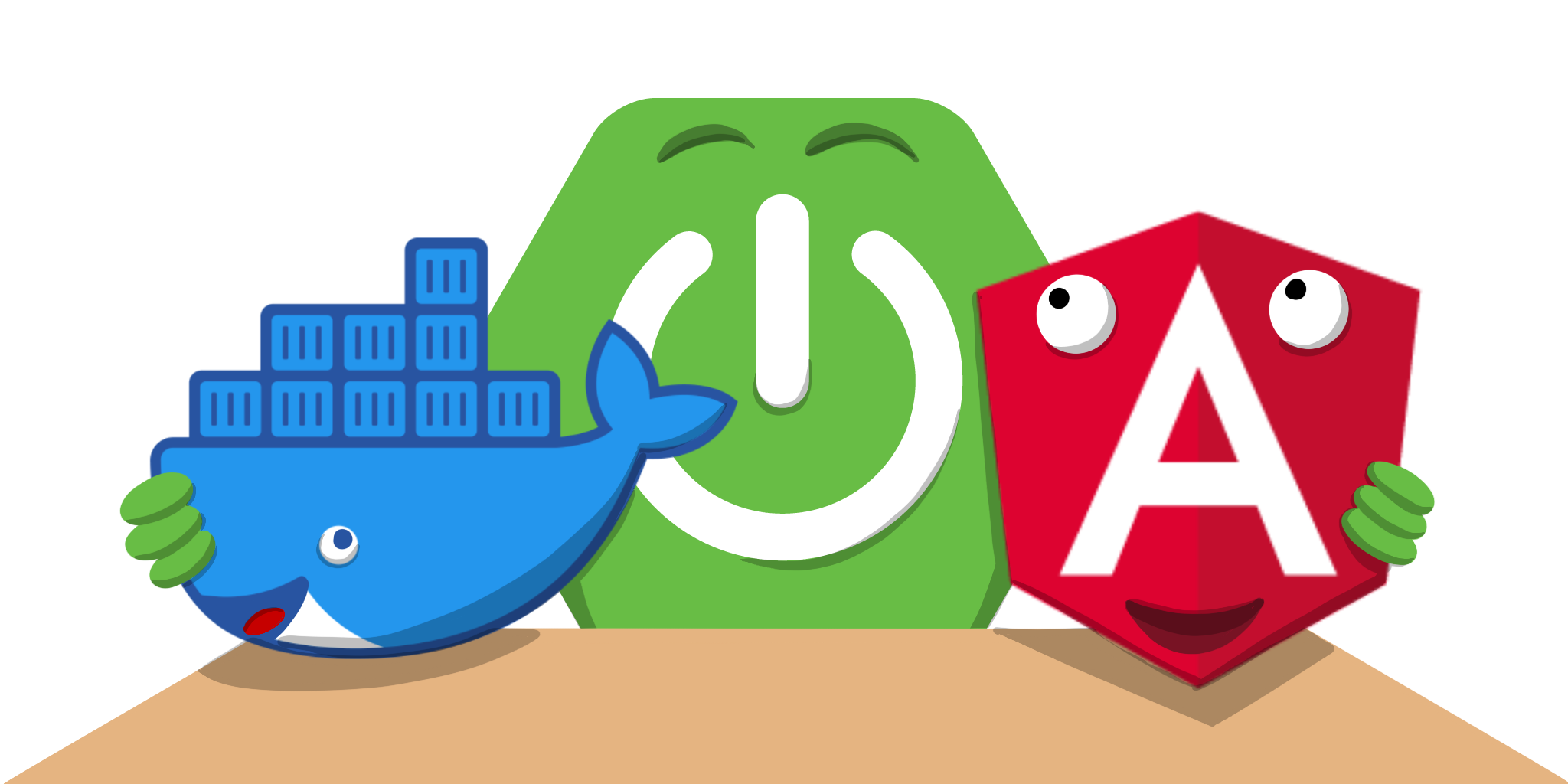
Building modern apps with Angular and Spring Boot is a common practice these days. In fact, if I use Google’s Keyword Planner to look up popular search terms, it’s one of the most popular combinations. The results in the list below are average monthly searches and not limited by location.

This tutorial is the fourth and final in a series on Angular and Spring Boot in 2020. In the first one, I showed how to create a secure notes app with Angular and Spring Boot + Kotlin. The second showed how to add Bootstrap for CSS and create a sortable, searchable, and pageable data table. The third showed how to deploy apps separately to Heroku. It also outlined how it’s possible to use ng deploy to deploy to Firebase, Netlify, and AWS. You can find links to previous tutorials below.
Today, I’ll show you how to use Docker to create an image for your Angular app and deploy it to Heroku. Then, I’ll show how to combine Angular and Spring Boot into the same JAR artifact for deployment. You’ll learn how to Dockerize the combined apps using Jib and Cloud Native Buildpacks. Finally, I’ll show you how to deploy your Docker image to Heroku, Knative on Google Cloud, and Cloud Foundry.

Docker is the most popular way to build and share containers. Dockerizing involves packaging your app—you can also include web servers to serve up your app. This is important when containerizing an Angular app because its artifacts are just JavaScript, CSS, and HTML; the production app is static files that will need to be served up by some sort of web server. As an added bonus, you can configure the web server to send security headers that make your app more secure.
- Create an Angular + Spring Boot App
- Create a Docker Container for Your Angular App
- Deploy Angular + Docker to Heroku
- Combine Your Angular + Spring Boot App into a Single JAR
- Dockerize Angular + Spring Boot with Jib
- Heroku 💜 Spring Boot + Docker
- Knative 💙 Spring Boot + Docker
- Cloud Foundry 💚 Spring Boot + Docker
- Use Cloud Native Buildpacks to Build Docker Images
- Easy Docker Images with Spring Boot 2.3
- Learn More About Angular, Spring Boot, and Docker
| You can also watch this tutorial as a screencast! |
Create an Angular + Spring Boot App
To begin, clone the GitHub repo from the most recent tutorial in this series.
git clone https://github.com/oktadeveloper/okta-angular-deployment-example.git \
angular-spring-boot-dockerPrerequisites:
Secure Your Angular + Spring Boot App with OpenID Connect
OAuth 2.0 was finalized in 2012 and has since become the industry-standard protocol for authorization. In 2014, OpenID Connect (OIDC) extended OAuth, adding federated identity to delegated authorization. Together, these two layers offer a standard specification that developers can write code against in a way that will work across multiple identity providers.
To begin the process of adding OIDC to Angular and Spring Boot, you’ll need to create a Heroku account. If you already have a Heroku account, log into it. Once you’re logged in, create a new app. I named mine bootiful-angular.
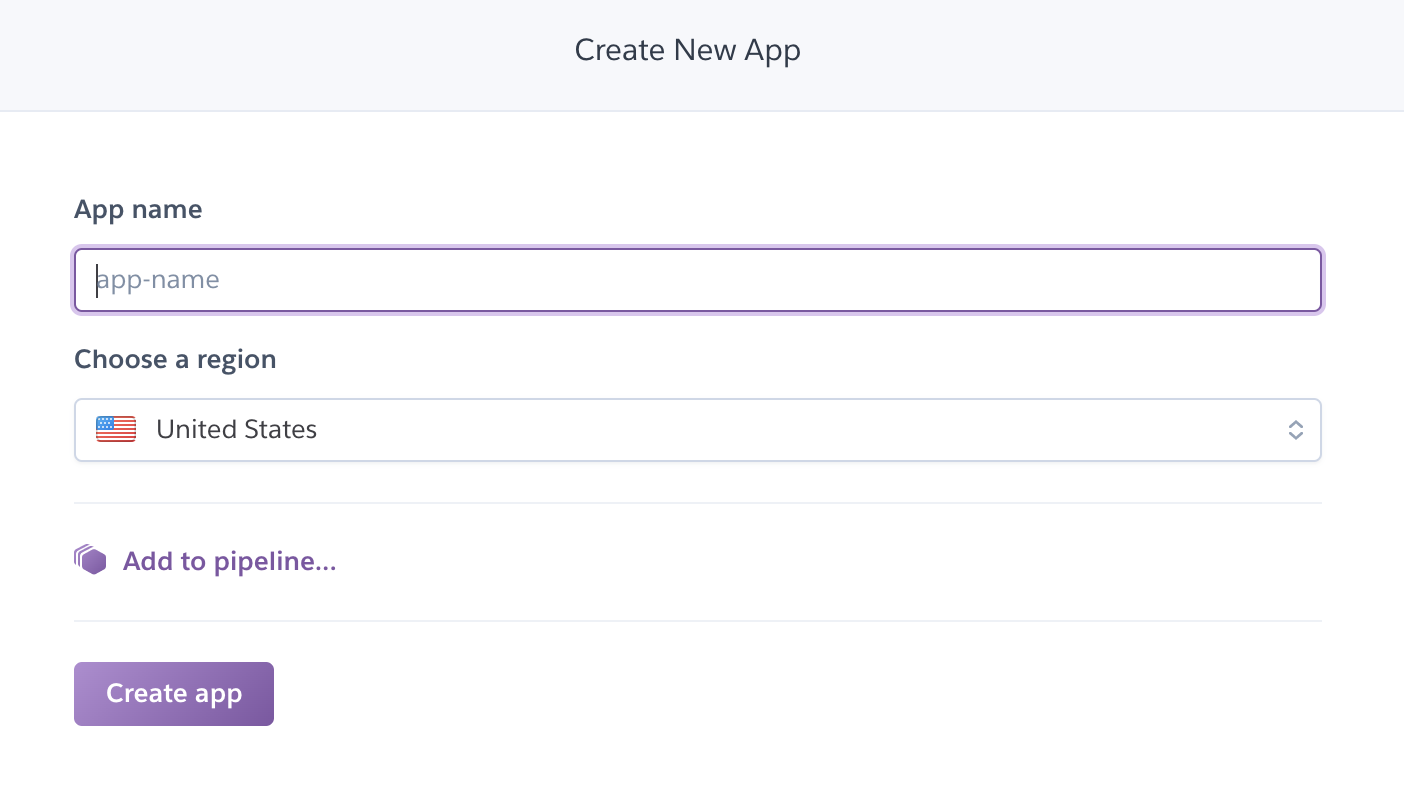
After creating your app, click on the Resources tab and add the Okta add-on.

| If you haven’t entered a credit card for your Heroku account, you will get an error. This is because Heroku requires you to have a credit card on file to use any of their add-ons, even free ones. This is part of Heroku’s assurance to guard against misuse (real person, real credit card, etc.). I think this is a good security practice. Add a credit card to continue. |
Click Provision and wait 20-30 seconds while your Okta account is created and OIDC apps are registered. Now go to your app’s Settings tab and click the Reveal Config Vars button. The variables displayed are the environment variables you can use to configure both Angular and Spring Boot for OIDC authentication.
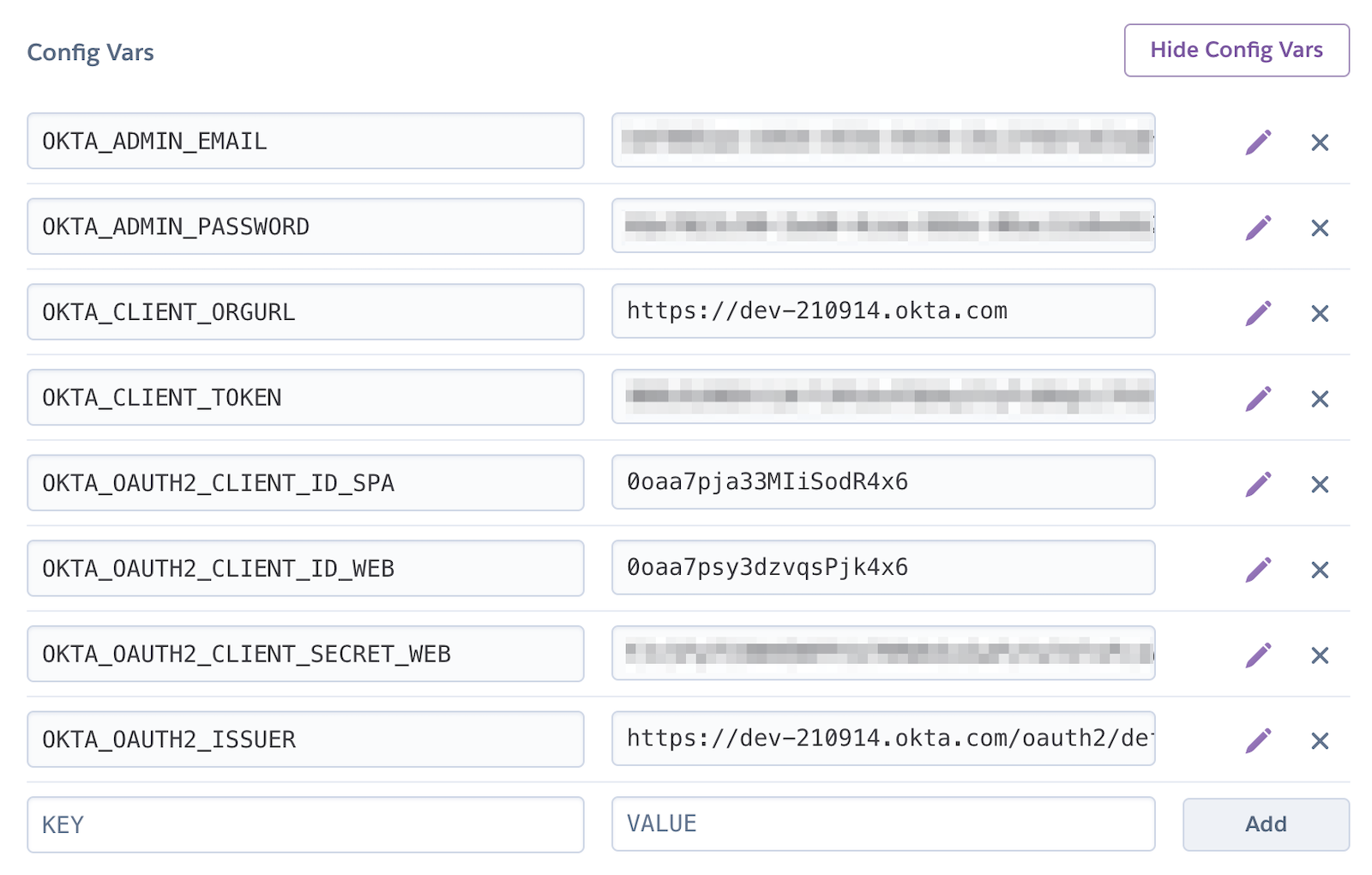
Create an okta.env file in the angular-spring-boot-docker/notes-api directory and copy the variable values into it, where $OKTA_* is the value from Heroku.
export OKTA_OAUTH2_ISSUER=$OKTA_OAUTH2_ISSUER
export OKTA_OAUTH2_CLIENT_ID=$OKTA_OAUTH2_CLIENT_ID_WEB
export OKTA_OAUTH2_CLIENT_SECRET=$OKTA_OAUTH2_CLIENT_SECRET_WEB|
If you’re on Windows without Windows Subsystem for Linux installed, create an |
Start your Spring Boot app by navigating to the notes-api directory, sourcing this file, and running bootRun.
source okta.env
./gradlew bootRunFor Windows users, the commands will be:
okta.bat
gradlew bootRunNext, configure Angular for OIDC authentication by modifying its auth-routing.module.ts to use the generated issuer and SPA client ID.
const oktaConfig = {
issuer: '$OKTA_OAUTH2_ISSUER',
redirectUri: window.location.origin + '/callback',
clientId: '$OKTA_OAUTH2_CLIENT_ID_SPA',
pkce: true
};Install your Angular app’s dependencies and start it.
npm i
ng serveOpen http://localhost:4200 in your browser.
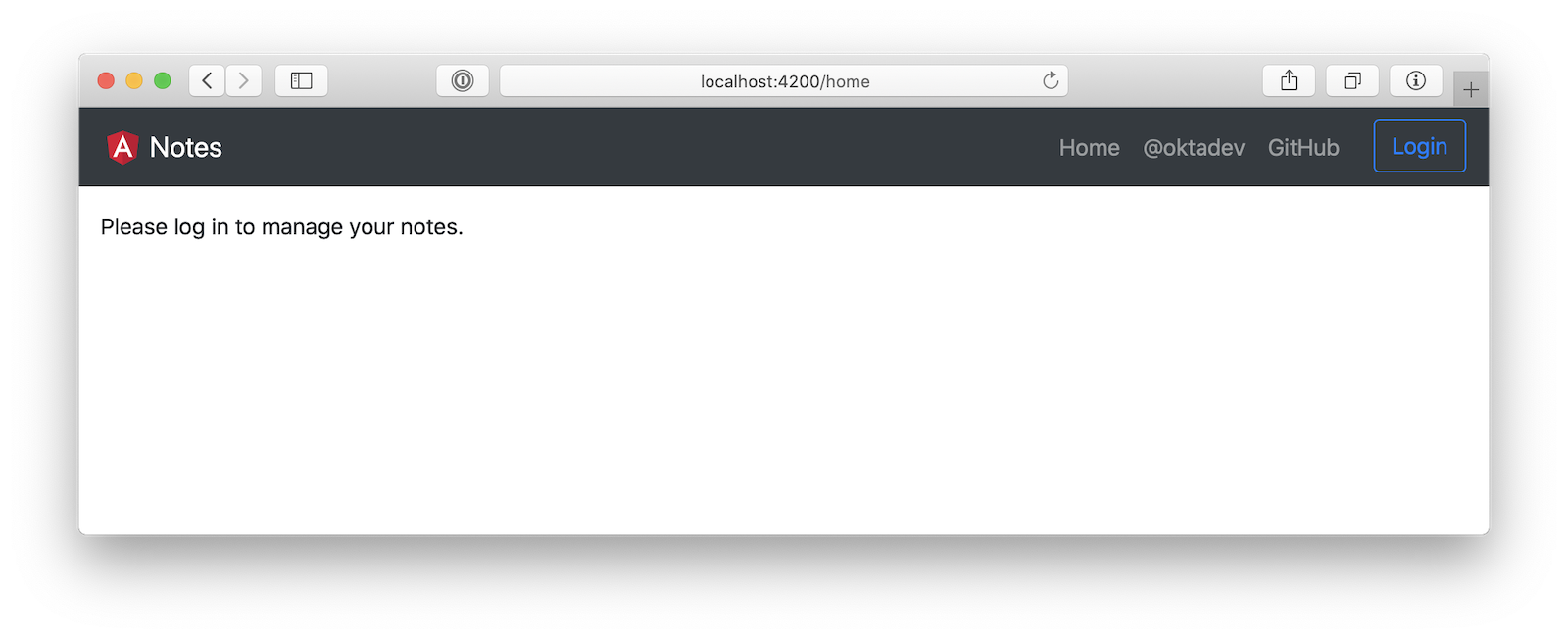
Click the Login button in the top right corner. You should be logged in without seeing a login form because you’re already logged in to Okta. If you want to see the full authentication flow, log out, or try it in a private window. You can use the $OKTA_ADMIN_EMAIL and $OKTA_ADMIN_PASSWORD from your Heroku config variables for credentials. Create a note to make sure everything works.
Commit your progress to Git from the top-level angular-spring-boot-docker directory.
git commit -am "Add Okta OIDC Configuration"Create a Docker Container for Your Angular App
Create a notes/Dockerfile that uses Node and Nginx as a web server.
FROM node:14.1-alpine AS builder
WORKDIR /opt/web
COPY package.json package-lock.json ./
RUN npm install
ENV PATH="./node_modules/.bin:$PATH"
COPY . ./
RUN ng build --prod
FROM nginx:1.17-alpine
COPY nginx.config /etc/nginx/conf.d/default.conf
COPY --from=builder /opt/web/dist/notes /usr/share/nginx/html|
When I was trying to get everything to work, I found it handy to comment out the This allows you to skip the lengthy Angular build process. |
This will build your project and add Nginx as a web server. You’ll need to create the nginx.config file to make Nginx SPA-aware.
server {
listen 80;
server_name _;
root /usr/share/nginx/html;
index index.html;
location / {
try_files $uri /index.html;
}
}Make sure your Docker daemon is running with docker ps. Then run the following command to build your Docker image. The ng-notes value can be whatever you want to name your image.
docker build -t ng-notes .If it builds successfully, you’ll see messages like the following:
Successfully built 382b9cd7d345
Successfully tagged ng-notes:latestYou can run it locally on port 4200 using the docker run command.
docker run -p 4200:80 ng-notesAdd these Docker commands as scripts to your package.json file.
"docker": "docker build -t ng-notes .",
"ng-notes": "docker run -p 4200:80 ng-notes"The docker run command will serve up the production version of the Angular app, which has its backend configured to point to a production URL on Heroku.
export const environment = {
production: true,
apiUrl: 'https://bootiful-angular.herokuapp.com'
};You’ll need to deploy your Spring Boot app to a similar public URL for your Angular + Docker container to work in production.
| If you already deployed Spring Boot to Heroku (from the last tutorial), you can skip the next section and go straight to deploying your Angular Docker container to Heroku. |
Deploy Spring Boot to Heroku
One of the easiest ways to interact with Heroku is with the Heroku CLI. Install it before proceeding with the instructions below.
brew tap heroku/brew && brew install herokuOpen a terminal and log in to your Heroku account.
heroku loginYou should already have a Heroku app that you’ve added Okta to. You can use it for hosting your Spring Boot app. Run heroku apps and you’ll see the one that you created.
$ heroku apps
=== matt.raible@okta.com Apps
bootiful-angularYou can run heroku config -a $APP_NAME to see your Okta variables. In my case, I’ll be using bootiful-angular for $APP_NAME.
Associate your existing Git repo with the app on Heroku.
heroku git:remote -a $APP_NAMESet the APP_BASE config variable to point to the notes-api directory. While you’re there, add the monorepo and Gradle buildpacks.
heroku config:set APP_BASE=notes-api
heroku buildpacks:add https://github.com/lstoll/heroku-buildpack-monorepo
heroku buildpacks:add heroku/gradleAttach a PostgreSQL database to your app.
heroku addons:create heroku-postgresqlBy default, Heroku’s Gradle support runs ./gradlew build -x test. Since you want it to run ./gradlew bootJar -Pprod, you’ll need to override it by setting a GRADLE_TASK config var.
heroku config:set GRADLE_TASK="bootJar -Pprod"The $OKTA_* environment variables don’t have the same names as the Okta Spring Boot starter expects. This is because the Okta Heroku Add-On creates two apps: a SPA and a web app. The web app’s config variables end in _WEB. You’ll have to make some changes so those variables are used for the Okta Spring Boot starter. Run the following command and remove _WEB from the two variables that have it.
heroku config:editNow you’re ready to deploy! Heroku makes this easy with a simple git push.
git push heroku main:masterRun heroku open to open your app. You’ll be redirected to Okta to authenticate, then back to your Spring Boot app. You should see a screen like the one below.
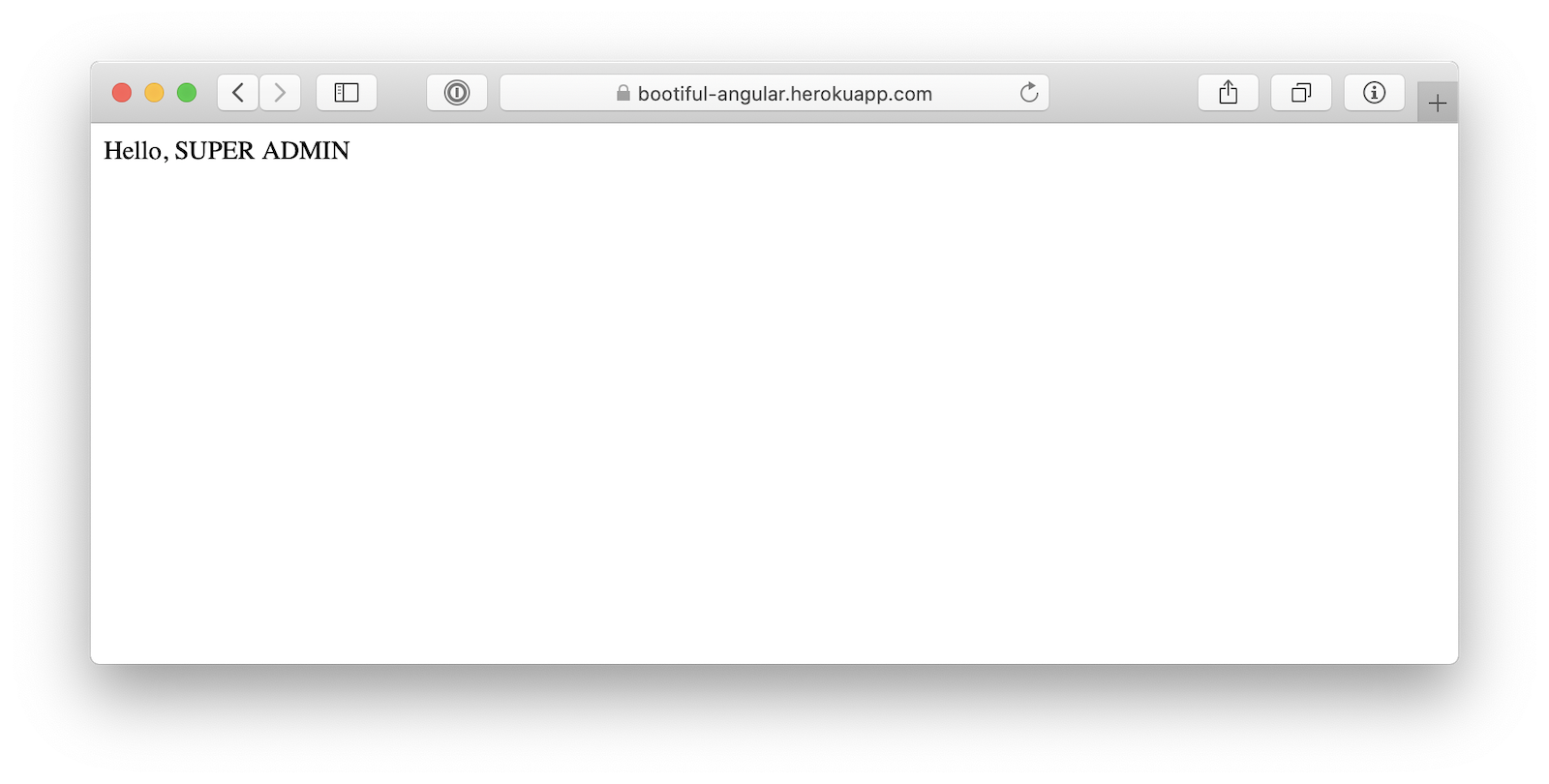
By default, JPA is configured to create your database schema each time. Change it to simply validate the schema.
heroku config:set SPRING_JPA_HIBERNATE_DDL_AUTO=validateNow, you’ll need to configure your Angular app to use your Heroku-deployed Spring Boot app for its production URL.
export const environment = {
production: true,
apiUrl: 'https://<your-heroku-app>.herokuapp.com'
};Since this runs the production build, you’ll need to add http://localhost:4200 as an allowed origin in your Spring Boot app on Heroku. Run the following command and add it to the end of the existing values.
heroku config:set ALLOWED_ORIGINS=http://localhost:4200| One advantage of doing this is that you can run your local Angular app against your production backend. I’ve found this very useful when debugging and fixing UI issues caused by production data. |
Now you should be able to rebuild your Angular Docker container and run it.
npm run docker
npm run ng-notesOpen your browser to http://localhost:4200, log in, and confirm you can add notes.
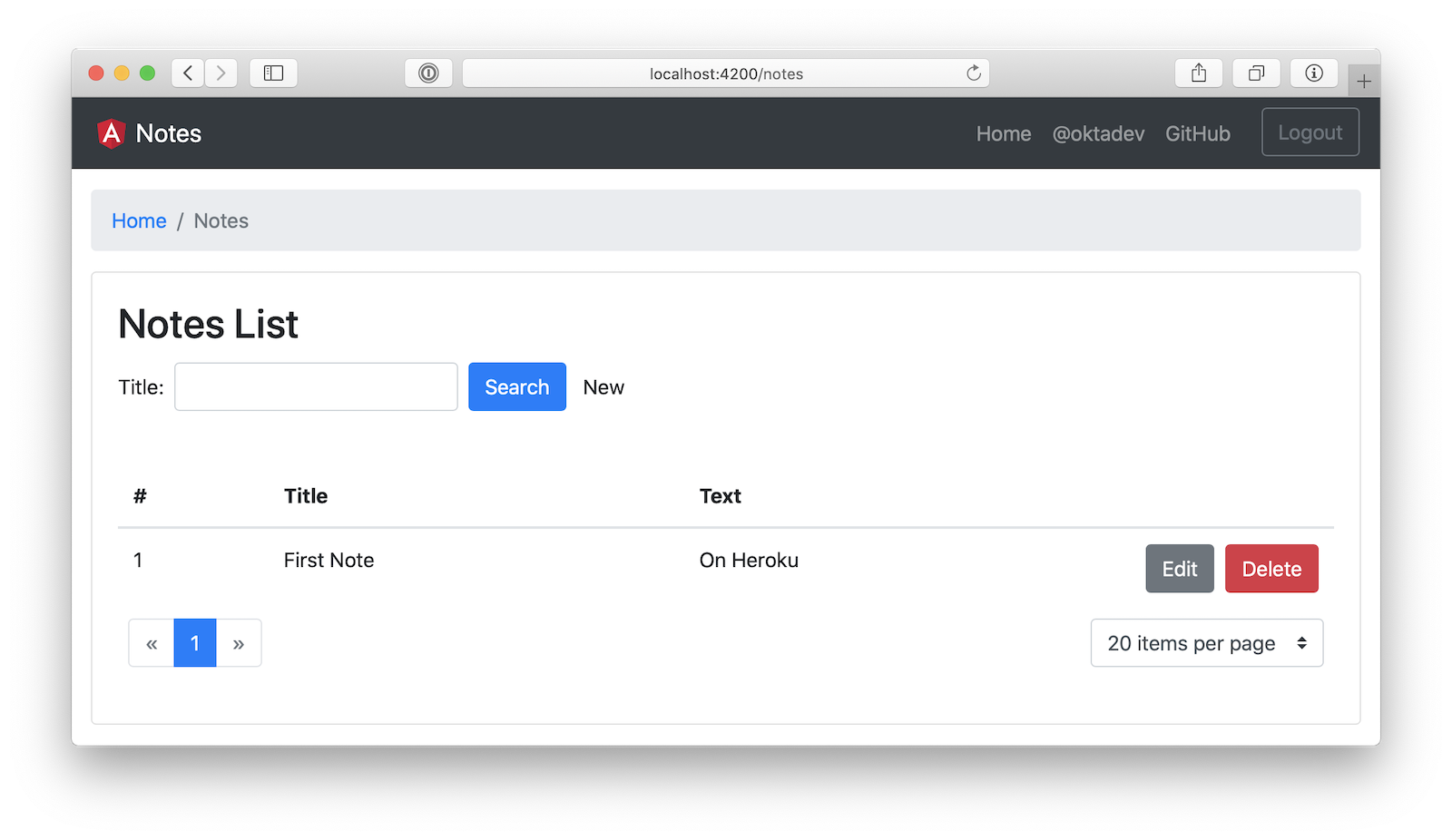
Verify the data made it to Heroku by going to https://<your-heroku-app>.herokuapp.com/api/notes.
Deploy Angular + Docker to Heroku
Heroku has several slick features when it comes to Docker images. If your project has a Dockerfile, you can deploy your app directly using the Heroku Container Registry.
First, make sure you’re in the notes directory, then log in to the Container Registry.
heroku container:loginThen, create a new app.
heroku createAdd the Git URL as a new remote named docker.
git remote add docker https://git.heroku.com/<your-app-name>.gitYou’ll need to update nginx.config so it reads from a $PORT environment variable if it’s set, otherwise default it to 80. You can use envsubst to do this at runtime. However, the default envsubst doesn’t allow default variables. The good news is a8m/envsubst on GitHub does!
Replace your nginx.config with the following configuration that defaults to 80 and escapes the $uri variable so it’s not replaced with a blank value.
server {
listen ${PORT:-80};
server_name _;
root /usr/share/nginx/html;
index index.html;
location / {
try_files $$uri /index.html;
}
}You’ll also need to update your Dockerfile so it uses the aforementioned envsubstr.
FROM node:14.1-alpine AS builder
WORKDIR /opt/web
COPY package.json package-lock.json ./
RUN npm install
ENV PATH="./node_modules/.bin:$PATH"
COPY . ./
RUN ng build --prod
FROM nginx:1.17-alpine
RUN apk --no-cache add curl
RUN curl -L https://github.com/a8m/envsubst/releases/download/v1.1.0/envsubst-`uname -s`-`uname -m` -o envsubst && \
chmod +x envsubst && \
mv envsubst /usr/local/bin
COPY ./nginx.config /etc/nginx/nginx.template
CMD ["/bin/sh", "-c", "envsubst < /etc/nginx/nginx.template > /etc/nginx/conf.d/default.conf && nginx -g 'daemon off;'"]
COPY --from=builder /opt/web/dist/notes /usr/share/nginx/htmlThen, push your Docker image to Heroku’s Container Registry.
heroku container:push web --remote dockerOnce the push process has completed, release the image of your app:
heroku container:release web --remote dockerAnd open the app in your browser:
heroku open --remote dockerYou’ll need to add your app’s URL to Okta as a valid redirect URI. In your Spring Boot app on Heroku, go to Resources and click on the okta add-on. This will log you in to the Okta Admin Console. Navigate to the Applications section, and Edit your app’s general settings. Add the following redirect URIs.
-
Login:
https://<angular-docker-app>.herokuapp.com/callback -
Logout:
https://<angular-docker-app>.herokuapp.com
You’ll need to add the new app’s URL as an allowed origin in your Spring Boot app on Heroku. Copy the printed Hosting URL value and run the following command.
heroku config:edit --remote herokuAdd the new URL after your existing localhost one, separating them with a comma. For example:
ALLOWED_ORIGINS='http://localhost:4200,https://<angular-docker-app>.herokuapp.com'Now you should be able to log in and see the note you created earlier.
A-Rated Security Headers for Nginx in Docker
If you test your freshly-deployed Angular app with securityheaders.com, you’ll get an F. To solve this, modify your nginx.config to add security headers.
server {
listen ${PORT:-80};
server_name _;
root /usr/share/nginx/html;
index index.html;
location / {
try_files $$uri /index.html;
}
add_header Content-Security-Policy "default-src 'self'; script-src 'self' 'unsafe-eval'; style-src 'self' 'unsafe-inline'; img-src 'self' data:; font-src 'self' data:; frame-ancestors 'none'; connect-src 'self' https://*.okta.com https://*.herokuapp.com";
add_header Referrer-Policy "no-referrer, strict-origin-when-cross-origin";
add_header Strict-Transport-Security "max-age=63072000; includeSubDomains";
add_header X-Content-Type-Options nosniff;
add_header X-Frame-Options DENY;
add_header X-XSS-Protection "1; mode=block";
add_header Feature-Policy "accelerometer 'none'; camera 'none'; microphone 'none'";
}After updating this file, run the following commands:
heroku container:push web --remote docker
heroku container:release web --remote dockerNow you should get an A!

Commit your changes to Git.
git add .
git commit -m "Add Docker for Angular"Combine Your Angular + Spring Boot App into a Single JAR
In the previous sections, you learned how to deploy your Angular and Spring Boot apps separately. Now I’ll show you how to combine them into a single JAR for production. You’ll still be able to run them independently in development, but deploying them to production will be easier because you won’t have to worry about CORS (cross-origin resource sharing). I’ll also convert the OAuth flows so they all happen server-side, which is more secure as the access token won’t be stored in the browser.
| Most client-side OAuth libraries keep access tokens in local storage. However, there is a oauth2-worker project that allows you to store them in a web worker. There’s also folks that think avoiding LocalStorage for tokens is the wrong solution. |
Update Your Angular App’s Authentication Mechanism
Create a new AuthService service that will communicate with your Spring Boot API for authentication logic.
import { Injectable } from '@angular/core';
import { Location } from '@angular/common';
import { BehaviorSubject, Observable } from 'rxjs';
import { HttpClient, HttpHeaders } from '@angular/common/http';
import { environment } from '../../environments/environment';
import { User } from './user';
import { map } from 'rxjs/operators';
const headers = new HttpHeaders().set('Accept', 'application/json');
@Injectable({
providedIn: 'root'
})
export class AuthService {
$authenticationState = new BehaviorSubject<boolean>(false);
constructor(private http: HttpClient, private location: Location) {
}
getUser(): Observable<User> {
return this.http.get<User>(`${environment.apiUrl}/user`, {headers}).pipe(
map((response: User) => {
if (response !== null) {
this.$authenticationState.next(true);
return response;
}
})
);
}
isAuthenticated(): Promise<boolean> {
return this.getUser().toPromise().then((user: User) => { (1)
return user !== undefined;
}).catch(() => {
return false;
})
}
login(): void { (2)
location.href =
`${location.origin}${this.location.prepareExternalUrl('oauth2/authorization/okta')}`;
}
logout(): void { (3)
const redirectUri = `${location.origin}${this.location.prepareExternalUrl('/')}`;
this.http.post(`${environment.apiUrl}/api/logout`, {}).subscribe((response: any) => {
location.href = response.logoutUrl + '?id_token_hint=' + response.idToken
+ '&post_logout_redirect_uri=' + redirectUri;
});
}
}| 1 | Talk to the /users endpoint to determine authenticated status. A username will be returned if the user is logged in. |
| 2 | When the user clicks a login button, redirect them to a Spring Security endpoint to do the OAuth dance. |
| 3 | Logout using the /api/logout endpoint, which returns the Okta Logout API URL and a valid ID token. |
Create a user.ts file in the same directory, to hold your User model.
export class User {
sub: number;
fullName: string;
}Update app.component.ts to use your new AuthService in favor of OktaAuthService.
import { Component, OnInit } from '@angular/core';
import { AuthService } from './shared/auth.service';
@Component({
selector: 'app-root',
templateUrl: './app.component.html',
styleUrls: ['./app.component.scss']
})
export class AppComponent implements OnInit {
title = 'Notes';
isAuthenticated: boolean;
isCollapsed = true;
constructor(public auth: AuthService) {
}
async ngOnInit() {
this.isAuthenticated = await this.auth.isAuthenticated();
this.auth.$authenticationState.subscribe(
(isAuthenticated: boolean) => this.isAuthenticated = isAuthenticated
);
}
}Remove OktaAuthModule and its related code from app.component.spec.ts and home.component.spec.ts. You’ll also need to add HttpClientTestingModule to their TestBed imports.
Change the buttons in app.component.html to reference the auth service instead of oktaAuth.
<button *ngIf="!isAuthenticated" (click)="auth.login()"
class="btn btn-outline-primary" id="login">Login</button>
<button *ngIf="isAuthenticated" (click)="auth.logout()"
class="btn btn-outline-secondary" id="logout">Logout</button>Update home.component.ts to use AuthService too.
import { Component, OnInit } from '@angular/core';
import { AuthService } from '../shared/auth.service';
@Component({
selector: 'app-home',
templateUrl: './home.component.html',
styleUrls: ['./home.component.scss']
})
export class HomeComponent implements OnInit {
isAuthenticated: boolean;
constructor(public auth: AuthService) {
}
async ngOnInit() {
this.isAuthenticated = await this.auth.isAuthenticated();
}
}Delete notes/src/app/auth-routing.module.ts and notes/src/app/shared/okta.
Modify app.module.ts to remove the AuthRoutingModule import, add HomeComponent as a declaration, and import HttpClientModule.
import { BrowserModule } from '@angular/platform-browser';
import { NgModule } from '@angular/core';
import { AppRoutingModule } from './app-routing.module';
import { AppComponent } from './app.component';
import { NoteModule } from './note/note.module';
import { NgbModule } from '@ng-bootstrap/ng-bootstrap';
import { HomeComponent } from './home/home.component';
import { HttpClientModule } from '@angular/common/http';
@NgModule({
declarations: [
AppComponent,
HomeComponent
],
imports: [
BrowserModule,
AppRoutingModule,
HttpClientModule,
NoteModule,
NgbModule
],
providers: [],
bootstrap: [AppComponent]
})
export class AppModule { }Add the route for HomeComponent to app-routing.module.ts.
import { HomeComponent } from './home/home.component';
const routes: Routes = [
{ path: '', redirectTo: '/home', pathMatch: 'full' },
{
path: 'home',
component: HomeComponent
}
];Change both environments.ts and environments.prod.ts to use a blank apiUrl.
apiUrl: ''Create a proxy.conf.js file to proxy certain requests to your Spring Boot API on http://localhost:8080.
const PROXY_CONFIG = [
{
context: ['/user', '/api', '/oauth2', '/login'],
target: 'http://localhost:8080',
secure: false,
logLevel: 'debug'
}
]
module.exports = PROXY_CONFIG;Add this file as a proxyConfig option in angular.json.
"serve": {
"builder": "@angular-devkit/build-angular:dev-server",
"options": {
"browserTarget": "notes:build",
"proxyConfig": "src/proxy.conf.js"
},
...
},Remove Okta’s Angular SDK and OktaDev Schematics from your Angular project.
npm uninstall @okta/okta-angular @oktadev/schematicsAt this point, your Angular app doesn’t contain any Okta-specific code for authentication. Instead, it relies on your Spring Boot app to provide that.
You should still be able to run ng serve in your Angular app and ./gradlew bootRun in your Spring Boot app for local development. However, you’ll need to make some adjustments to your Spring Boot app to include Angular for production.
Configure Spring Boot to Include Your Angular SPA
In your Spring Boot app, you’ll need to change a number of things. You’ll need to configure Gradle to build your Angular app when you pass in -Pprod, you’ll need to adjust its routes (so it’s SPA-aware and routes all 404s to index.html), and you’ll need to modify Spring Security to allow HTML, CSS, and JavaScript to be anonymously accessed.
To begin, delete src/main/kotlin/com/okta/developer/notes/HomeController.kt. You’ll no longer need this because your Angular app will be served up at the / path.
Next, create a RouteController.kt that routes all requests to index.html.
package com.okta.developer.notes
import org.springframework.stereotype.Controller
import org.springframework.web.bind.annotation.RequestMapping
import javax.servlet.http.HttpServletRequest
@Controller
class RouteController {
@RequestMapping(value = ["/{path:[^\\.]*}"])
fun redirect(request: HttpServletRequest): String {
return "forward:/"
}
}Modify SecurityConfiguration.kt to allow anonymous access to static web files, the /user info endpoint, and to add additional security headers.
package com.okta.developer.notes
import org.springframework.security.config.annotation.web.builders.HttpSecurity
import org.springframework.security.config.annotation.web.configuration.EnableWebSecurity
import org.springframework.security.config.annotation.web.configuration.WebSecurityConfigurerAdapter
import org.springframework.security.web.csrf.CookieCsrfTokenRepository
import org.springframework.security.web.header.writers.ReferrerPolicyHeaderWriter
import org.springframework.security.web.util.matcher.RequestMatcher
@EnableWebSecurity
class SecurityConfiguration : WebSecurityConfigurerAdapter() {
override fun configure(http: HttpSecurity) {
//@formatter:off
http
.authorizeRequests()
.antMatchers("/**/*.{js,html,css}").permitAll()
.antMatchers("/", "/user").permitAll()
.anyRequest().authenticated()
.and()
.oauth2Login()
.and()
.oauth2ResourceServer().jwt()
http.requiresChannel()
.requestMatchers(RequestMatcher {
r -> r.getHeader("X-Forwarded-Proto") != null
}).requiresSecure()
http.csrf()
.csrfTokenRepository(CookieCsrfTokenRepository.withHttpOnlyFalse())
http.headers()
.contentSecurityPolicy("script-src 'self'; report-to /csp-report-endpoint/")
.and()
.referrerPolicy(ReferrerPolicyHeaderWriter.ReferrerPolicy.SAME_ORIGIN)
.and()
.featurePolicy("accelerometer 'none'; camera 'none'; microphone 'none'")
//@formatter:on
}
}| See Spring Security’s headers documentation to see default security headers and other options. |
With Kotlin, you can mark parameters and return values as optional by adding ? to their type. Update the user() method in UserController.kt to make OidcUser optional. It will be null when the user is not authenticated, that’s why this change is needed.
@GetMapping("/user")
fun user(@AuthenticationPrincipal user: OidcUser?): OidcUser? {
return user;
}Previously, Angular handled logout. Add a LogoutController that will handle expiring the session as well as sending information back to Angular so it can logout from Okta.
package com.okta.developer.notes
import org.springframework.http.ResponseEntity
import org.springframework.security.core.annotation.AuthenticationPrincipal
import org.springframework.security.oauth2.client.registration.ClientRegistration
import org.springframework.security.oauth2.client.registration.ClientRegistrationRepository
import org.springframework.security.oauth2.core.oidc.OidcIdToken
import org.springframework.web.bind.annotation.PostMapping
import org.springframework.web.bind.annotation.RestController
import javax.servlet.http.HttpServletRequest
@RestController
class LogoutController(val clientRegistrationRepository: ClientRegistrationRepository) {
val registration: ClientRegistration = clientRegistrationRepository.findByRegistrationId("okta");
@PostMapping("/api/logout")
fun logout(request: HttpServletRequest,
@AuthenticationPrincipal(expression = "idToken") idToken: OidcIdToken): ResponseEntity<*> {
val logoutUrl = this.registration.providerDetails.configurationMetadata["end_session_endpoint"]
val logoutDetails: MutableMap<String, String> = HashMap()
logoutDetails["logoutUrl"] = logoutUrl.toString()
logoutDetails["idToken"] = idToken.tokenValue
request.session.invalidate()
return ResponseEntity.ok().body<Map<String, String>>(logoutDetails)
}
}
In OpenID Connect Logout Options with Spring Boot, Brian Demers describes this as RP-Initiated Logout. He also shows how you can configure Spring Security’s OidcClientInitiatedLogoutSuccessHandler to logout. I tried this technique but decided against it because it doesn’t allow me to redirect back to my Angular app in dev mode. I also encountered some CORS errors that I was unable to solve.
|
When you access the /user/notes endpoint with Angular, the ${principal.name} expression correctly resolves to the user’s email. However, when you access this endpoint after logging in directly to Spring Boot, it resolves to the sub claim. To make these values consistent, add the following property to application-dev.properties and application-prod.properties.
spring.security.oauth2.client.provider.okta.user-name-attribute=preferred_usernameYou can also remove the allowed.origins property from both files since Angular will proxy the request in development (eliminating the need for CORS) and there won’t be cross-domain requests in production.
Add a server.port property to application-prod.properties that uses a PORT environment variable, if it’s set.
server.port=${PORT:8080}Because there won’t be any cross-domain requests, you can remove the simpleCorsFilter bean and allowedOrigins variable in DemoApplication.kt, too.
Modify Gradle to Build a JAR with Angular Included
Now that your Spring Boot app is ready to serve up your Angular app, you need to modify your Gradle configuration to build your Angular app and package it in the JAR.
Start by importing NpmTask and adding the Node Gradle plugin.
import com.moowork.gradle.node.npm.NpmTask
plugins {
...
id("com.github.node-gradle.node") version "2.2.4"
...
}Then, define the location of your Angular app and configuration for the Node plugin.
val spa = "${projectDir}/../notes";
node {
version = "12.16.2"
nodeModulesDir = file(spa)
}Add a buildWeb task:
val buildWeb = tasks.register<NpmTask>("buildNpm") {
dependsOn(tasks.npmInstall)
setNpmCommand("run", "build")
setArgs(listOf("--", "--prod"))
inputs.dir("${spa}/src")
inputs.dir(fileTree("${spa}/node_modules").exclude("${spa}/.cache"))
outputs.dir("${spa}/dist")
}And modify the processResources task to build Angular when -Pprod is passed in.
tasks.processResources {
rename("application-${profile}.properties", "application.properties")
if (profile == "prod") {
dependsOn(buildWeb)
from("${spa}/dist/notes") {
into("static")
}
}
}Now you should be able to combine both apps using ./gradlew bootJar -Pprod. Once it’s built, run it with the following commands to ensure everything works.
docker-compose -f src/main/docker/postgresql.yml up -d
source okta.env
java -jar build/libs/*.jarCongrats! You modified your Angular and Spring Boot apps to be packaged together and implemented the most secure form of OAuth 2.0 to boot! 🎊
Commit your changes to Git.
git add .
git commit -m "Combine Angular and Spring Boot"Dockerize Angular + Spring Boot with Jib
Since everything is done via Gradle now, you can use plugins to build a Docker container. Jib builds optimized Docker images without the need for deep mastery of Docker best-practices. It reads your Gradle/Maven build files for its metadata.
To add Jib support, add its Gradle plugin.
plugins {
...
id("com.google.cloud.tools.jib") version "2.4.0"
}Then, at the end of this file, add jib configuration to specify your image name and the active Spring profile.
jib {
to {
image = "<your-username>/bootiful-angular"
}
container {
environment = mapOf("SPRING_PROFILES_ACTIVE" to profile)
}
}Run the following command to build a Docker image with Jib.
./gradlew jibDockerBuild -Pprod
If you want to override the image name in build.gradle.kts, you can pass in an --image parameter. For example, ./gradlew jibDockerBuild -Pprod --image=bootiful-ng9.
|
Run Your Spring Boot Docker App with Docker Compose
In theory, you should be able to run the following command to run your app.
docker run --publish=8080:8080 <your-username>/bootiful-angularHowever, Spring Boot won’t start because you haven’t configured the Okta environment variables. You could pass them in on the command line, but it’s easier to specify them in a file.
You can use Docker Compose and its env_file option to specify environment variables.
Copy notes-api/okta.env to src/main/docker/.env.
Remove export at the beginning of each line. It should resemble something like the following after this change:
OKTA_OAUTH2_ISSUER=https://dev-210914.okta.com/oauth2/default
OKTA_OAUTH2_CLIENT_ID=0oaa7psy...
OKTA_OAUTH2_CLIENT_SECRET=FJcSFpTC6N...Create a src/main/docker/app.yml file that configures your app to set environment variables and leverages your existing PostgreSQL container. Make sure to replace the <your-username> placeholder and make the image match what’s in your build.gradle.kts file.
version: '2'
services:
boot-app:
image: <your-username>/bootiful-angular
environment:
- SPRING_DATASOURCE_URL=jdbc:postgresql://notes-postgresql:5432/notes
- OKTA_OAUTH2_ISSUER=${OKTA_OAUTH2_ISSUER}
- OKTA_OAUTH2_CLIENT_ID=${OKTA_OAUTH2_CLIENT_ID}
- OKTA_OAUTH2_CLIENT_SECRET=${OKTA_OAUTH2_CLIENT_SECRET}
ports:
- 8080:8080
depends_on:
- notes-postgresql
notes-postgresql:
extends:
file: postgresql.yml
service: notes-postgresqlDocker Compose expects the .env file to be in the directory you run docker-compose from, so you have two choices:
-
Navigate to the
src/main/dockerdirectory before runningdocker-compose -
Create a symlink to
.envin your root directory:ln -s src/main/docker/.env
If you choose option #1, run:
cd src/main/docker
docker-compose -f app.yml upOption #2 looks like:
docker-compose -f src/main/docker/app.yml upOnce you’ve verified everything works, commit your changes to Git.
git add .
git commit -m "Add Jib to build Docker images"Deploy Your Spring Boot + Angular Container to Docker Hub
Jib makes it incredibly easy to deploy your container to Docker Hub. If you don’t already have a Docker Hub account, you can create one.
Run docker login to log into your account, then use the jib task to build and deploy your image.
./gradlew jib -PprodIsn’t it cool how Jib makes it so you don’t need a Dockerfile!? 👍
Heroku 💜 Spring Boot + Docker
To deploy this container to Heroku, create a new Heroku app and add it as a Git remote.
heroku create
git remote add jib https://git.heroku.com/<your-new-app>.gitAt this point, you can use the PostgreSQL and Okta add-ons you’ve already configured. If you’d like to do this, use addons:attach instead of addons:create in the following commands. Since both add-ons are free, I’m just going to show how to create new ones.
Add PostgreSQL to this app and configure it for Spring Boot using the following commands:
heroku addons:create heroku-postgresql --remote jib
heroku config:get DATABASE_URL --remote jib
heroku config:set SPRING_DATASOURCE_URL=jdbc:postgresql://<value-after-@-from-last-command> --remote jib
heroku config:set SPRING_DATASOURCE_USERNAME=<username-value-from-last-command> --remote jib
heroku config:set SPRING_DATASOURCE_PASSWORD=<password-value-from-last-command> --remote jib
heroku config:set SPRING_DATASOURCE_DRIVER_CLASS_NAME=org.postgresql.Driver --remote jib
This fine-grained configuration is not necessary when you use Heroku’s buildpacks to deploy your Spring Boot app. It injects scripts that set SPRING_* environment variables for you. In this case, Heroku doesn’t know you’re using Spring Boot since it’s running in a container.
|
Add Okta to your app.
heroku addons:create okta --remote jibTo see your database and Okta environment variables, run:
heroku config --remote jibModify the Okta environment variables to remove the _WEB on the two keys that have it.
heroku config:edit --remote jibRun the commands below to deploy the image you deployed to Docker Hub. Be sure to replace the <…> placeholders with your username and app name.
docker tag <your-username>/bootiful-angular registry.heroku.com/<heroku-app>/web
docker push registry.heroku.com/<heroku-app>/web
heroku container:release web --remote jibFor example, I used:
docker tag mraible/bootiful-angular registry.heroku.com/enigmatic-woodland-19325/web
docker push registry.heroku.com/enigmatic-woodland-19325/web
heroku container:release web --remote jibYou can watch the logs to see if your container started successfully.
heroku logs --tail --remote jibOnce you’ve verified it has started OK, set the Hibernate configuration so it only validates the schema.
heroku config:set SPRING_JPA_HIBERNATE_DDL_AUTO=validate --remote jibSince the Okta Add-on for Heroku configures everything for you, you should be able to open your app, click the Login button, and authenticate!
heroku open --remote jibIf you test your Dockerfied Angular + Spring Boot app on securityheaders.com, you’ll see it scores an A+!

Knative 💙 Spring Boot + Docker
Heroku is awesome, but sometimes people want more control over their infrastructure. Enter Knative. It’s like Heroku in that it’s a Platform as a Service (PaaS). Knative is built on top of Kubernetes so you can install a number of services with a bit of YAML and kubectl commands.
With Heroku, when companies reach the limitations of the platform, they have to go elsewhere to host their services. With Knative, you can just drop down to Kubernetes. It’s Heroku for Kubernetes in a sense, but you don’t have to switch to a different universe when you need additional functionality.
The Knative website says it’ll make your developers more productive.
Knative components build on top of Kubernetes, abstracting away the complex details and enabling developers to focus on what matters. Built by codifying the best practices shared by successful real-world implementations, Knative solves the "boring but difficult" parts of deploying and managing cloud native services, so you don’t have to.
You’ll need a Google Cloud account for this section. Go to cloud.google.com and click Get started for free.
Once you have an account, go to Google Cloud Console and create a new project.
Then, click on the Terminal icon in the top right to open a Cloud Shell terminal for your project.
Enable Cloud and Container APIs:
gcloud services enable \
cloudapis.googleapis.com \
container.googleapis.com \
containerregistry.googleapis.com| This command can take a minute or two to complete. |
When it’s done, set your default zone and region:
gcloud config set compute/zone us-central1-c
gcloud config set compute/region us-central1And create a Kubernetes cluster:
gcloud beta container clusters create knative \
--addons=HorizontalPodAutoscaling,HttpLoadBalancing \
--machine-type=n1-standard-4 \
--cluster-version=1.15 \
--enable-stackdriver-kubernetes --enable-ip-alias \
--enable-autoscaling --min-nodes=5 --num-nodes=5 --max-nodes=10 \
--enable-autorepair \
--scopes cloud-platformYou can safely ignore the warnings that result from running this command.
Next, set up a cluster administrator and install Istio.
kubectl create clusterrolebinding cluster-admin-binding \
--clusterrole=cluster-admin \
--user=$(gcloud config get-value core/account)
kubectl apply -f \
https://github.com/knative/serving/raw/v0.14.0/third_party/istio-1.5.1/istio-crds.yaml
while [[ $(kubectl get crd gateways.networking.istio.io -o jsonpath='{.status.conditions[?(@.type=="Established")].status}') != 'True' ]]; do
echo "Waiting on Istio CRDs"; sleep 1
done
kubectl apply -f \
https://github.com/knative/serving/raw/v0.14.0/third_party/istio-1.5.1/istio-minimal.yamlNow, you should be able to install Knative!
kubectl apply --selector knative.dev/crd-install=true -f \
https://github.com/knative/serving/releases/download/v0.14.0/serving.yaml
kubectl apply -f \
https://github.com/knative/serving/releases/download/v0.14.0/serving.yaml
while [[ $(kubectl get svc istio-ingressgateway -n istio-system \
-o 'jsonpath={.status.loadBalancer.ingress[0].ip}') == '' ]]; do
echo "Waiting on external IP"; sleep 1
doneYou’ll need a domain to enable HTTPS, so set that up and point it to the cluster’s IP address.
export IP_ADDRESS=$(kubectl get svc istio-ingressgateway -n istio-system \
-o 'jsonpath={.status.loadBalancer.ingress[0].ip}')
echo $IP_ADDRESS
kubectl apply -f - <<EOF
apiVersion: v1
kind: ConfigMap
metadata:
name: config-domain
namespace: knative-serving
data:
$IP_ADDRESS.nip.io: ""
EOFInstall cert-manager to automatically provision and manage TLS certificates in Kubernetes.
kubectl apply --validate=false -f \
https://github.com/jetstack/cert-manager/releases/download/v0.14.3/cert-manager.yaml
kubectl wait --for=condition=Available -n cert-manager deployments/cert-manager-webhookAnd configure free TLS certificate issuing with Let’s Encrypt.
kubectl apply -f - <<EOF
apiVersion: cert-manager.io/v1alpha2
kind: ClusterIssuer
metadata:
name: letsencrypt-http01-issuer
spec:
acme:
privateKeySecretRef:
name: letsencrypt
server: https://acme-v02.api.letsencrypt.org/directory
solvers:
- http01:
ingress:
class: istio
EOF
kubectl apply -f \
https://github.com/knative/serving/releases/download/v0.14.0/serving-cert-manager.yaml
kubectl apply -f - <<EOF
apiVersion: v1
kind: ConfigMap
metadata:
name: config-certmanager
namespace: knative-serving
data:
issuerRef: |
kind: ClusterIssuer
name: letsencrypt-http01-issuer
EOF
kubectl apply -f - <<EOF
apiVersion: v1
kind: ConfigMap
metadata:
name: config-network
namespace: knative-serving
data:
autoTLS: Enabled
httpProtocol: Enabled
EOFPhew! That was a lot of kubectl and YAML, don’t you think?! The good news is you’re ready to deploy PostgreSQL and your Spring Boot app.
The following command can deploy everything, but you’ll need to change the <…> placeholders to match your values first.
kubectl apply -f - <<EOF
apiVersion: v1
kind: PersistentVolumeClaim
metadata:
name: pgdata
annotations:
volume.alpha.kubernetes.io/storage-class: default
spec:
accessModes: [ReadWriteOnce]
resources:
requests:
storage: 1Gi
---
apiVersion: apps/v1beta1
kind: Deployment
metadata:
name: postgres
spec:
replicas: 1
template:
metadata:
labels:
service: postgres
spec:
containers:
- name: postgres
image: postgres:10.1
ports:
- containerPort: 5432
env:
- name: POSTGRES_DB
value: bootiful-angular
- name: POSTGRES_USER
value: bootiful-angular
- name: POSTGRES_PASSWORD
value: <your-db-password>
volumeMounts:
- mountPath: /var/lib/postgresql/data
name: pgdata
subPath: data
volumes:
- name: pgdata
persistentVolumeClaim:
claimName: pgdata
---
apiVersion: v1
kind: Service
metadata:
name: pgservice
spec:
ports:
- port: 5432
name: pgservice
clusterIP: None
selector:
service: postgres
---
apiVersion: serving.knative.dev/v1alpha1
kind: Service
metadata:
name: bootiful-angular
spec:
template:
spec:
containers:
- image: <your-username>/bootiful-angular
env:
- name: SPRING_DATASOURCE_URL
value: jdbc:postgresql://pgservice:5432/bootiful-angular
- name: SPRING_DATASOURCE_USERNAME
value: bootiful-angular
- name: SPRING_DATASOURCE_PASSWORD
value: <your-db-password>
- name: OKTA_OAUTH2_ISSUER
value: <your-okta-issuer>
- name: OKTA_OAUTH2_CLIENT_ID
value: <your-okta-client-id>
- name: OKTA_OAUTH2_CLIENT_SECRET
value: <your-okta-client-secret>
EOFOnce the deployment has completed, run the command below to change it so Hibernate doesn’t try to recreate your schema on restart.
kubectl apply -f - <<EOF
apiVersion: serving.knative.dev/v1alpha1
kind: Service
metadata:
name: bootiful-angular
spec:
template:
spec:
containers:
- image: <your-username>/bootiful-angular
env:
- name: SPRING_DATASOURCE_URL
value: jdbc:postgresql://pgservice:5432/bootiful-angular
- name: SPRING_DATASOURCE_USERNAME
value: bootiful-angular
- name: SPRING_DATASOURCE_PASSWORD
value: <your-db-password>
- name: OKTA_OAUTH2_ISSUER
value: <your-okta-issuer>
- name: OKTA_OAUTH2_CLIENT_ID
value: <your-okta-client-id>
- name: OKTA_OAUTH2_CLIENT_SECRET
value: <your-okta-client-secret>
- name: SPRING_JPA_HIBERNATE_DDL_AUTO
value: validate
EOFIf everything works correctly, you should be able to run the following command to get the URL of your app.
kubectl get ksvc bootiful-angularThe result should look similar to this:
NAME URL LATESTCREATED LATESTREADY READY REASON
bootiful-angular https://bootiful-angular.default.34.70.42.153.nip.io bootiful-angular-qf9hn bootiful-angular-qf9hn TrueYou’ll need to add this URL (+ /login/oauth2/code/okta) as a Login redirect URI and a Logout redirect URI in Okta in order to log in.
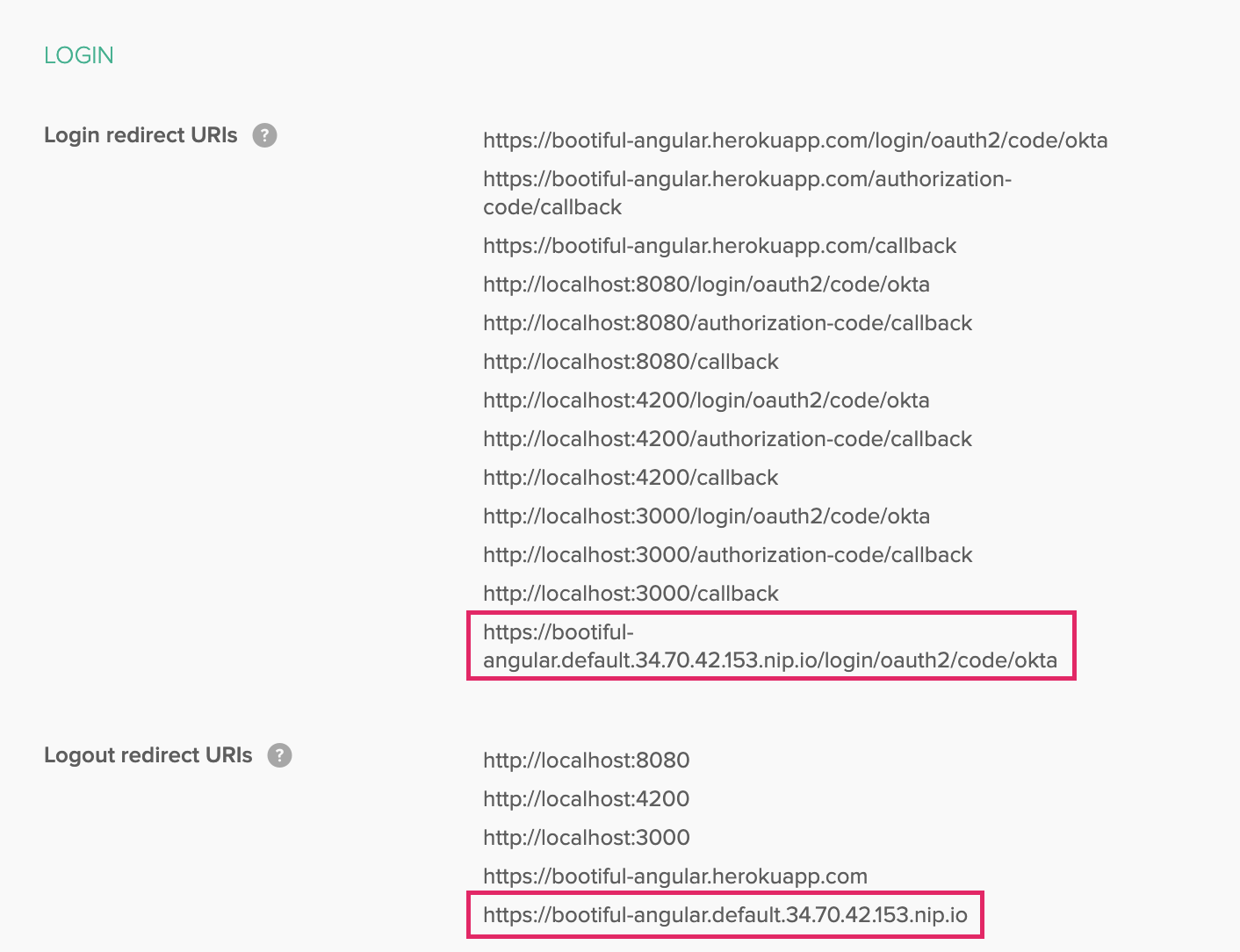
Then, you’ll be able to log into your app running on Knative! Add a note or two to prove it all works.
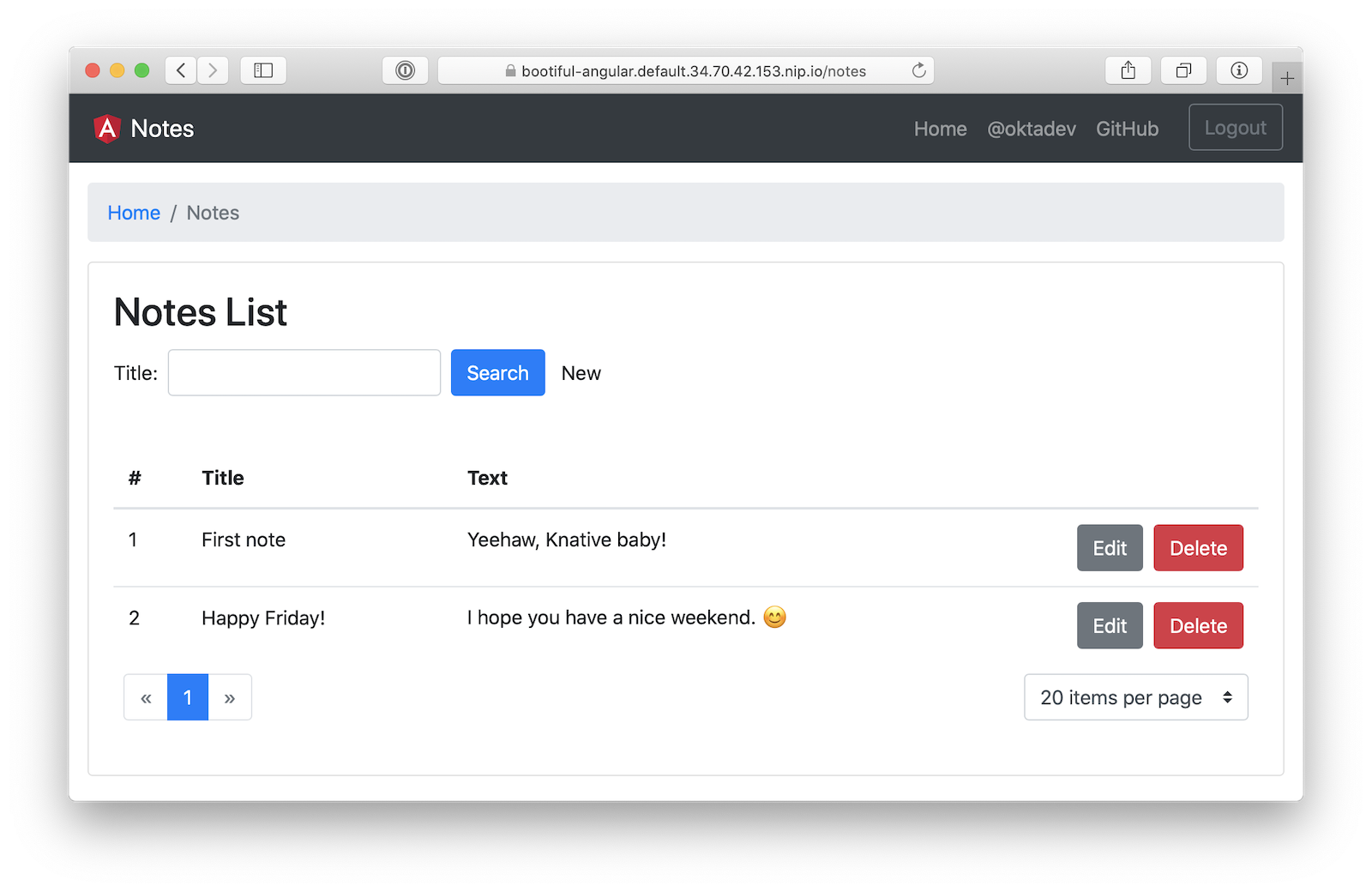
Cloud Foundry 💚 Spring Boot + Docker
Did you know you can run Docker containers on Cloud Foundry? It’s pretty slick.
If you’d like to test it out, you’ll need a Pivotal Web Services account. You’ll also need to install the Cloud Foundry CLI. If you’re using Homebrew, you can use brew install cloudfoundry/tap/cf-cli.
Apps deployed to Cloud Foundry (CF) with the cf push command run in standard CF Linux containers. With Docker support enabled, CF can also deploy and manage apps running in Docker containers.
Then, where secure-notes is a unique name for your app, run the following commands.
cf login
# Deploy the image from Docker Hub
cf push --no-start -o <your-username>/bootiful-angular secure-notes
# Create a PostgreSQL instance
cf cs elephantsql turtle secure-notes-psql
# Bind the app to the PostgreSQL instance
cf bs secure-notes secure-notes-psqlAt this point, you’ll need to set a number of environment variables so your app can connect to PostgreSQL and Okta. Substitute your values in the <…> placeholders before running the command below.
To get your PostgreSQL URL run the following command where secure-notes is your app name.
cf env secure-notesYou will see a uri at the top of the output that has the URL you’ll need to parse and set as variables below. Make sure to replace postgres:// with jdbc:postgresql:// at the beginning of the datasource URL and extract the credentials for the username and password settings.
export APP_NAME=<your-app-name>
cf set-env $APP_NAME SPRING_DATASOURCE_DRIVER_CLASS_NAME org.postgresql.Driver
cf set-env $APP_NAME SPRING_DATASOURCE_URL <postgresql-jdbc-url>
cf set-env $APP_NAME SPRING_DATASOURCE_USERNAME <postgresql-username>
cf set-env $APP_NAME SPRING_DATASOURCE_PASSWORD <postgresql-passord>
cf set-env $APP_NAME OKTA_OAUTH2_ISSUER <your-okta-issuer>
cf set-env $APP_NAME OKTA_OAUTH2_CLIENT_ID <your-okta-client-id>
cf set-env $APP_NAME OKTA_OAUTH2_CLIENT_SECRET <your-okta-client-id>
cf restage $APP_NAMEYour app, running in Docker, should now be available at http://<your-app-name>.cfapps.io.
You’ll need to add this URL (+ /login/oauth2/code/okta) as a Login redirect URI and Logout redirect URI on Okta in order to log in.
You’ll also want to configure JPA so it doesn’t recreate the schema on each restart.
cf set-env $APP_NAME SPRING_JPA_HIBERNATE_DDL_AUTO validateNow you should be able to loginlog in and add notes to your heart’s content!
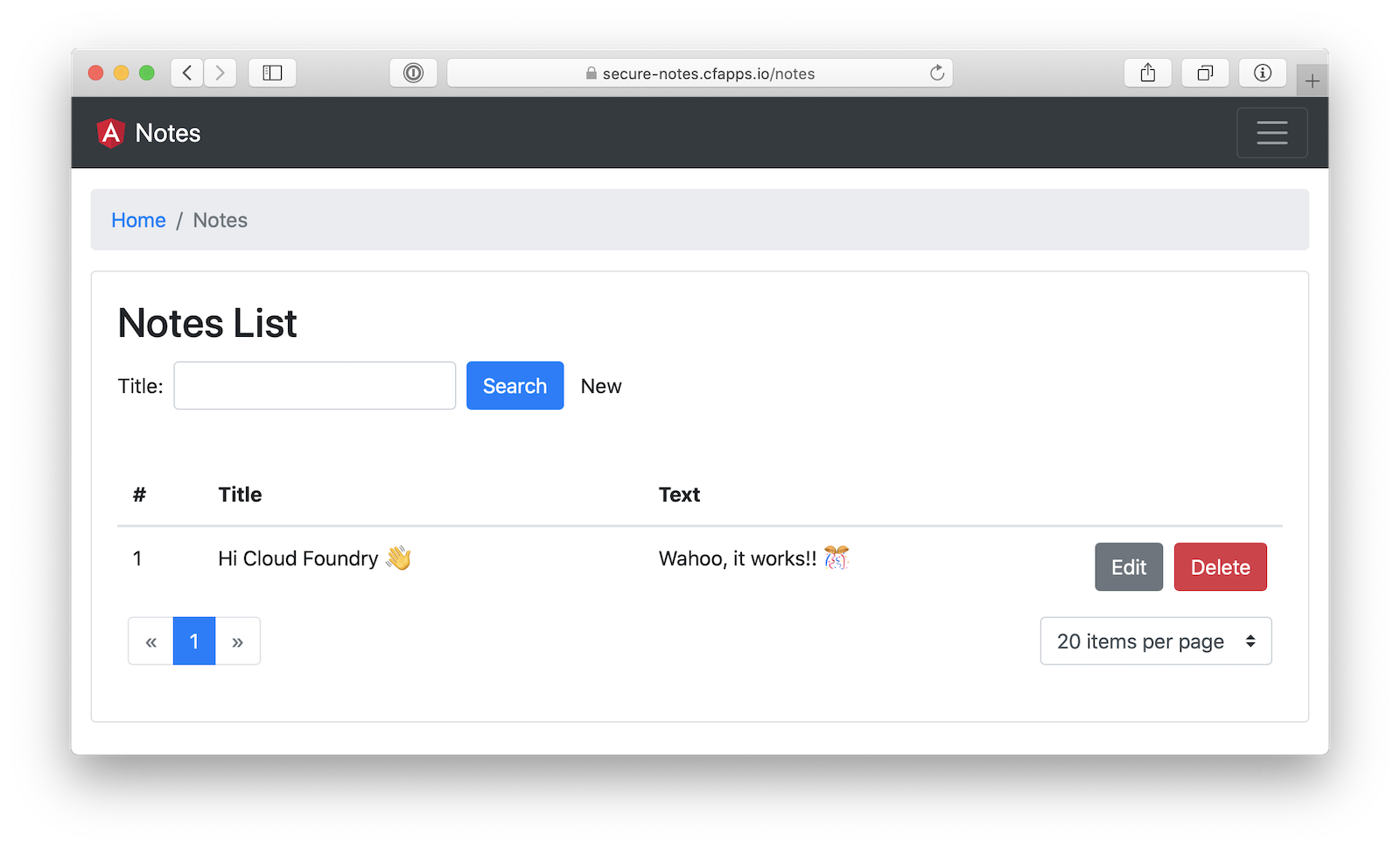
You can also just use a manifest.yml to make it so you don’t have to type all the commands above.
applications:
- name: <your-app-name>
disk_quota: 1G
docker:
image: <your-username>/bootiful-angular
env:
OKTA_OAUTH2_CLIENT_ID: <your-okta-client-id>
OKTA_OAUTH2_CLIENT_SECRET: <your-okta-client-secret>
OKTA_OAUTH2_ISSUER: <your-okta-issuer>
SPRING_DATASOURCE_DRIVER_CLASS_NAME: org.postgresql.Driver
SPRING_DATASOURCE_PASSWORD: <postgresql-password>
SPRING_DATASOURCE_URL: <postgresql-jdbc-url>
SPRING_DATASOURCE_USERNAME: <postgresql-username>
instances: 1
memory: 1G
routes:
- route: http://<your-app-name>.cfapps.io
services:
- <your-app-name>-psql
stack: cflinuxfs3Since most of these environment variables should probably be externally specified, it’s not much gain to use the manifest.yml in this case. Storing secrets in source control is a bad idea!
If you do decide to store everything in manifest.yml, make sure to add it to .gitignore.
|
With a manifest.yml in place, you can simply run cf push and it’ll do the same thing as the aforementioned cf commands.
Use Cloud Native Buildpacks to Build Docker Images
Cloud Native Buildpacks is an initiative that was started by Pivotal and Heroku in early 2018. It has a pack CLI that allows you to build Docker images using buildpacks.
Unfortunately, pack doesn’t have great support for monorepos (especially in sub-directories) yet. I was unable to make it work with this app structure.
On the upside, Spring Boot 2.3’s built-in support for creating Docker images works splendidly!
Easy Docker Images with Spring Boot 2.3
Spring Boot 2.3.0 is now available and with it comes built-in Docker support. It leverages Cloud Native Buildpacks, just like the pack CLI.
Spring Boot’s Maven and Gradle plugins both have new commands:
-
./mvnw spring-boot:build-image -
./gradlew bootBuildImage
The Paketo Java buildpack is used by default to create images.
| Learn more in Phil Webb’s blog post: Creating Docker images with Spring Boot 2.3.0.M1 or his excellent What’s new in Spring Boot 2.3 video. |
By default, Spring Boot will use your $artifactId:$version for the image name. That is, notes-api:0.0.1-SNAPSHOT. You can override this with an --imageName parameter.
Build and run the image with the commands below.
./gradlew bootBuildImage --imageName <your-username>/bootiful-angular -Pprod
docker-compose -f src/main/docker/app.yml upYou should be able to navigate to http://localhost:8080, log in, and add notes.

Pretty neat, don’t you think!? 😃
Learn More About Angular, Spring Boot, and Docker
This lengthy tutorial showed you a lot of options when it comes to deploying your Angular and Spring Boot apps with Docker:
-
Build Angular containers with
Dockerfile -
Combine Angular and Spring Boot in a JAR
-
Build Docker images with Jib
-
Build Docker images with Buildpacks
You can find the source code for this example on GitHub at oktadeveloper/okta-angular-spring-boot-docker-example.
As a developer, you probably don’t want to do a series of tutorials to get to a baseline to start a project. The good news is JHipster does everything in this series. It allows you to run your Angular and Spring Boot apps separately, use Kotlin on the server, package your apps together for production, and use Docker for distribution.
To learn more about Angular, Spring Boot, and Docker, see some of our other blog posts.
Follow @oktadev on Twitter for more posts like this one. We also have a YouTube channel you might enjoy. As always, please leave a comment below if you have any questions!
Changelog:
- Nov 21, 2021: Added announcement about The Angular Mini-Book. Its "Angular and Docker" chapter was inspired by this blog post.
- Jun 18, 2020: Updated to Spring Boot 2.3.1, Angular 9.1.11, and the latest Okta Heroku Add-on. See the code changes in the example app on GitHub. Changes to this article can be viewed in oktadeveloper/okta-blog#331.





Okta Developer Blog Comment Policy
We welcome relevant and respectful comments. Off-topic comments may be removed.